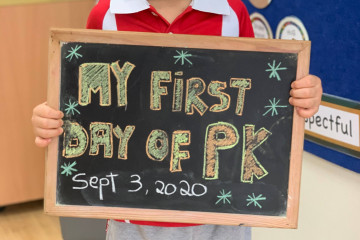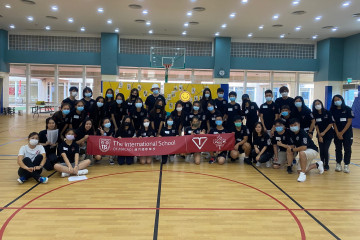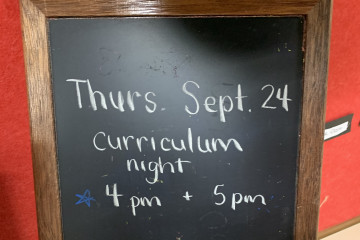
When Children Speak More Than One Language
There is no difference for children or adults when learning two languages. Language acquisition takes time and many opportunities to practice. A language learner (one, two or more languages) needs to hear other people use each language often. In addition to hearing a language, the language learner needs practice talking in each language.
First we listen, then we speak.
A child’s language at birth is non-verbal, evidence of how language is learned - first we listen, then we speak.
Multiple theories of language acquisition agree that depending on which language you want to learn and your mother tongue, the average person must listen to between 1,000 and 2,000 hours of spoken language before starting to speak. This listening exposure happens more quickly when the learner is living in an English speaking environment.
Students at The International School of Macao (TIS) spend approximately 35 hours per week in school. Consequently, 1,000 to 2,000 hours of listening to English at school will take students who are not having English experiences outside of school between 28 to 54 weeks. At this stage of learning, the language learner may be hesitant to speak. Some language learning students are hesitant to speak English in front of others in case they make an error.
Students who listen to English outside of their time in school typically learn the language at a faster rate. Students are encouraged to listen to English outside of school hours to accelerate language learning. One grade seven student when asked how he was able to advance his language reading level in one year claimed it was from watching the news in English every day, while a beginning language student in grade three used characters from an English cartoon, Pinky and Brain, as an infrastructure to begin his storytelling and writing.
Listening to language contributes to language acquisition. Once a person has accumulated knowledge of the English language through listening, they may lack confidence to begin speaking. David Long, Head of World ALG Thai language program in Bangkok explains, “The reason why most people find learning a language difficult is because they don’t get enough input before they try to produce output. While listening is the best way to acquire language, the second best way is reading and studying. Whatever the means of input, you need to hit your thousand hours mark if you hope to speak.”
The conversational skills of listening and speaking are referred to by linguists as BICS - Basic Interpersonal Communication Skills and may take from 3-4 years to develop. When a child learning English can engage in conversational English, this does not mean they have mastered the English language. Conversational language is what the language learner and others observe on the surface; listening and speaking is not an indication of skills necessary to successfully navigate study in a language learner’s second language.
Learners of spoken English often have errors in pronunciation, basic vocabulary and grammatical errors, and these errors may last a long time. Some language learners fossilize or plateau (“process in which incorrect language becomes a habit and cannot easily be corrected”). Students may disengage from actively seeking to learn more English skills, they become complacent and are no longer aware of or don’t care about their errors because they feel functional on a conversational (listening and speaking) level.
Currently research speculates a correlation that fossilization can also happen in the absence of correction and feedback in a supportive educational setting. Teacher expectations for correct grammar can be reinforced through modeling, recasting, and error correcting strategies combined with consistent expectations and heightened language awareness (voice recording and error tracking) within the classroom. Habits, however, are difficult to break, unless there is motivation to do so.
With more social interaction comes more English learning.
Social activities in English promote language learning - for example, there are English language learning opportunities for middle school students who watch English movies while they eat lunch together. Participating in extracurricular activities (ECA’s) is a great way for TIS students to boost their language learning.
Home Language
Important to note is the relationship between learning the English language, and maintaining and developing the language learner’s home language and culture. Research shows that when children are developing two languages at the same time, the two developing languages build on each other rather than take away from each other. The stronger the first (or home) language proficiency is, the stronger the second language proficiency will be, particularly with academic literacy. Maintaining the home language is key to a child’s success in attaining the second language.
So to use an English idiom expression, “Don’t throw the baby out with the bath water”. In other words, don’t discard the essential (your home language) while pursuing English as a second language.
Where does reading and writing fit into language acquisition?
Listening and speaking are two of the four strands in language acquisition. Typically when a person lives in a country where they are immersed in a new language, reading and writing the new language are the last skills to develop. Expanding, Bridging and Extending are the language skill learning stages referred to by linguists as CALP - Cognitive Academic Language Proficiency. These higher levels of language skill development will require an additional 5-7 years to develop and are necessary for success in Grade 12 diploma courses.
Find out more information about Basic Interpersonal Communication Skills (BICS) and Cognitive Academic Language Proficiency (CALP):
English version
Chinese version
Quick Facts:
How long does it take for children to learn English?
3-4 years for conversational English
5-7 years for full academic English
Why do some children learn English faster than others?
Quality and quantity of English exposure
The more books read in English and the more English speaking friends they have, the more practice children have with English, and the more English vocabulary they will build
Aptitude learning skill, a set of verbal and memory abilities that vary between individuals and can be inherent.
Age of acquisition:
Starting to learn English early, before the ages of six to eight years old, is better for developing pronunciation and grammar.
Starting to learn English a little late, after six to eight years of age, results in faster vocabulary growth and development of skills such as storytelling.
It is important to remember that there is no age within the childhood years when it is ‘too early’ or ‘too late’ to learn another language. Each child’s English development will follow its own timetable; every individual learns in their own way at their own pace.
Later this year in a future Vision article, I will provide additional information on what cognitive academic language is, how the academic language develops and is acquired, and what this means to TIS students.
References and citations:
“Characteristics of English Language Learners” Alberta Education, Government of Alberta,
learnalberta.ca/content/eslapb/documents/CharacteristicsofEnglishLanguageLearners.pdf
del Carmen Diego Amado, Maria. “Teaching Implications and Fossilization in the Field of Second Language Acquisition”, Salamanca,
2016, TGSemedoRodriguezJTeachingimplications.pdf
“Fossilization”, n.d., British Council,
teachingenglish.org.uk/article/fossilization
“Interlanguage and Fossilization” , 2020, Costa Rica
Englishpost.org
Long, David. “Three Cups of Language”, 28 Sept.2008, brooklynmonk.wordpress.com/2008/09/28/three-cups-of-language/
“Working with Young English Language Learners” Alberta Education, Government of Alberta,
education.alberta.ca/media/1224523/working-with-young-children-who-are-learning-english-as-a-new-language.pdf



